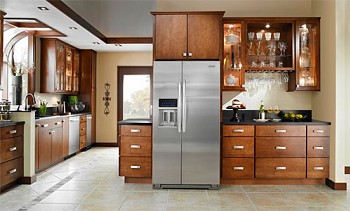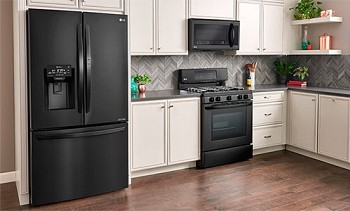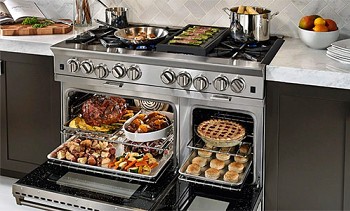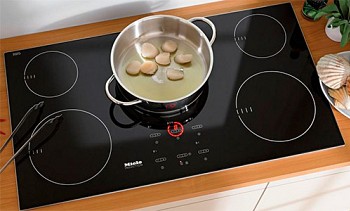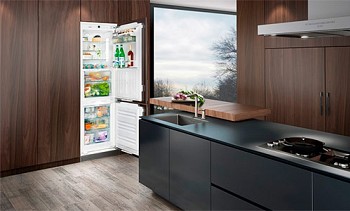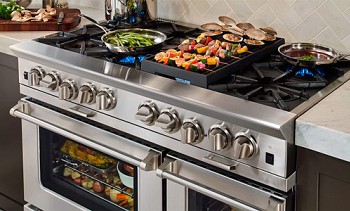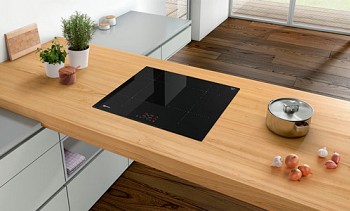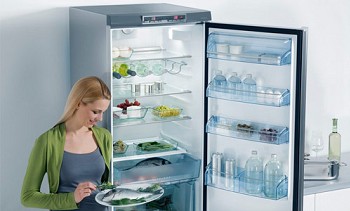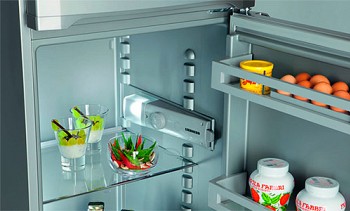To determine which hood is better for the kitchen, you can only pre-perform some calculations, which will at least take into account the size of the room and the presence of a ventilation system in it. Not the last factor will be the design of the device - not every housewife wants to “plant” a “black sheep” in the kitchen, which does not know how to fit into her interior.
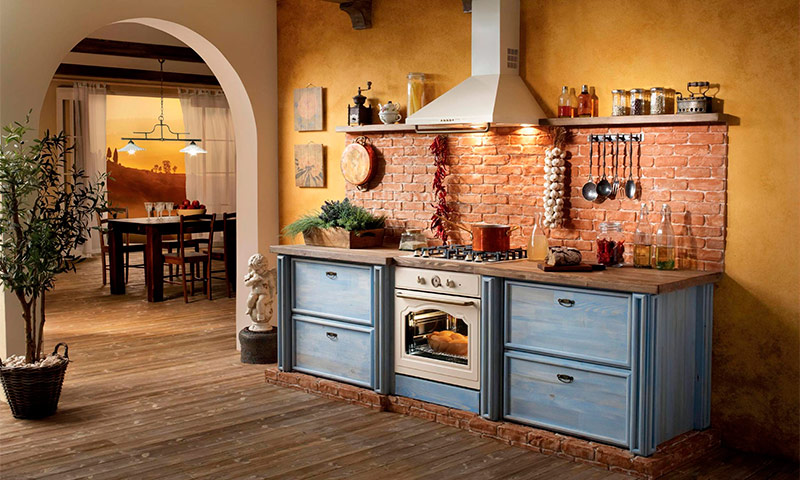
What hood is better to choose for the kitchen
If you can not think much about the design of the hood, since there are quite different models on the market with their colors and sizes, then you need to pay special attention to the efficiency of its work - the quality of the functions it performs depends on it.
First of all, you need to determine the type of device - select recirculating or flow. At the same time, without a preliminary assessment of the room, it is unambiguous to say which cooker hoods it is better to use for it, it will not work - each performs its tasks and is good in its place.
Circulation hood
This device got its name because it simply makes air circulate around the room, eliminating odors by passing it through a charcoal filter, which is located inside the hood itself.
In addition to the charcoal filter, grease traps are installed in such a hood.
The principle of its operation determines all the positive and negative sides of this design.


+ The advantages of circulation hoods
- Possibility of use in houses with a clogged ventilation system or simply designed for small traction and can not cope with the capabilities of modern range hoods.
- Such a device can be placed anywhere and you do not have to pull the corrugation from the ventilation shaft to it. It also opens up great opportunities for designers - such a hood can be hidden in a countertop or behind a false wall.
- Air recirculation does not require strong traction, which means devices can be more compact and more economical in terms of energy consumption.
- With lower loads on the engine, which is the main component of the hood, the overall service life of the device increases.
- The location of the cooking plate is not tied to the ventilation shaft.

- Cons of circulation hoods
- The need to purchase consumables - depending on the intensity of use of the hood, carbon filters should be changed approximately every six months to a year.
- You will have to regularly wash the grease filter - it is a fine metal mesh that is installed in the lower part of the hood and cleaned in running water or a dishwasher.
- It makes no sense to put a circulation hood over a gas stove. In the process of gas combustion, oxygen from the air is converted into carbon monoxide (CO²), which the hood will simply drive through the kitchen. Recycling in this case becomes not only ineffective, but also hazardous to health.
Flow hood
The main difference between such a device is that for effective operation, it definitely needs access to the ventilation shaft. The hood is mounted either directly near its opening, or is connected to it by a corrugated pipe, which is made as short as possible - the smaller it is, the quieter the operation of the hood. For this reason, devices of this type are somewhat limited in the place of installation - on the wall above the stove or ceiling.
The principle of operation of the device is quite simple.The fan blows air and draws it out of the room, forming a kind of draft, which is formed when the window is open, only the air does not spin in the kitchen, but is blown by the fan into the ventilation shaft or directly into the street, if a separate ventilation hole is made in the kitchen wall for exhausting.

Since dirty air is discharged into the street, there is no need to use carbon filters, but in order to prevent particles of grease and soot from becoming contaminated by the inside of the hood, the grease filter is still placed on it. It must be washed periodically - it depends on the purity of this part how much the hood will work efficiently and quietly.
Due to the need for ventilation installation, it is better to install flow hoods during repair work in the kitchen and when planning it, calculate its location separately. Particular attention should be paid to the duct - ideally, it should be a straight line without bends or turns. If they are present, the air will buzz strongly inside the pipe and the use of the hood will be at least not comfortable. In general, according to the principle of operation, it is clear which hood for a gas stove is better - in this case, only a flow hood should be installed. Almost all models of flow hoods can be run in recirculation mode - for this, a carbon filter is installed on the outlet and the device is ready for operation.

+ Pros of a flow hood
- The ability to make powerful, high-performance devices.
- There are no consumables that need systematic replacement - the used grease filters are almost eternal.
- Hoods can be hidden in the kitchen furniture.
- Noisiness is lower than that of circulation analogues.

- Cons of a flow hood
- Since the hood essentially pumps air out of the kitchen, another must flow in its place, for which it is necessary to leave the window open or to think through the ventilation also to the air flow.
- A consequence of the previous drawback - in winter, the hood removes warm air from the room, replacing it with cold air, and vice versa in summer.
- If the stove is located (or will be installed) far from the ventilation hole, large-scale installation work is inevitable.
What to choose the design of the hood according to the type of installation
Here, the design question comes to the forefront, because the fundamentally internal arrangement of all hoods is the same - the main differences are in engine power, build quality and the applied lighting of the working area.
Outboard. Mostly, these are low-cost device options - they differ in small engine power, but at the same time the most economical in terms of energy consumption. The simplicity of the design determines the cost of such hoods and the simplicity of their installation. Most often this is a 60x50x15 case, the lower part of which consists of grease filters, and the engine is located inside. The duct is located on the top or back cover.
Despite the budget version, in this category there are a sufficient number of reliable devices that can cope with air purification no worse than TOP models and at the same time they will have a fairly low noise level.

Dome. Their second name is mantelpieces. They got this name for their resemblance to the ventilation system of natural fireplaces, which immediately attracts attention when entering the kitchen. Often, such models are equipped with a powerful engine and boast high performance. Since they are constantly in sight, manufacturers offer customers a large number of design options for such devices.

Structurally, dome hoods are divided into three types:
1. Wall. They are mounted on one of the walls, for which the back side is made flat.

2. Corner They have the appropriate form for installation in the corner of the kitchen.

3. Island. They are attached to the ceiling - most often a ventilation pipe is passed through it.It is especially simple to do this if plasterboard ceilings are mounted. Such a hood is used in large kitchens in which the stove is in the middle of the room.

Wall and corner devices can have an inclined working surface - this improves their appearance, and also reduces the likelihood of hitting the edge of a conventional hood with a head.
Recessed. After installation, such hoods become almost invisible - only the control panel with touch or mechanical buttons remains in sight. Usually this is a narrow strip a few centimeters high - black, white or silver.
Such hoods can be embedded in kitchen cabinets or countertops - in the first case they extend in the horizontal plane, and in the second (such models are also called “dominoes”) - in the vertical one.

Hood built into the cabinet.

Hood built into the countertop.
The best hanging hoods for the kitchen
This rating of kitchen hoods includes representatives of the Slovenian brand Gorenie, domestic Kronasteel and Italian manufacturer LEX. All hoods have approximately the same characteristics and cope with their duties at a good level, so the design criteria, the familiar brand name and customer reviews using similar devices will most likely become the selection criteria.
 |  |  | |||||||
|---|---|---|---|---|---|---|---|---|---|
| Gorenje DU 5345 W | Kronasteel Jessica slim PB 600 white | LEX Simple 600 Inox | |||||||
 |
 |
 |
|||||||
| Width / Depth / Height, cm | 50 / 13 / 48,5 | 60 / 8 / 50 | 60 / 15 / 50 | ||||||
| Power consumption | 150 | 240 | 180 | ||||||
| Max. productivity, m3/hour. | 300 | 350 | 340 | ||||||
| Type of management | electronic | mechanical | mechanical | ||||||
| Lamps used for lighting | halogen | incandescent | incandescent | ||||||
| Max. noise level, dB | 54 | 58 | 52 | ||||||
| Diameter of the duct pipe, mm | 120 | 120 | 120 | ||||||
| Mode of operation | retraction / circulation | retraction / circulation | retraction / circulation | ||||||
| Number of speeds | 3 | 3 | 3 | ||||||
| Type of filters | fatty | fatty + charcoal | fatty | ||||||
Gorenje DU 5345 W
The operation of the hood is provided by a three-speed electric motor - despite the size, the device has a capacity of up to 300 m³ / h, which is quite enough for air purification in the kitchen with an area of up to 10 m². Management of modes and the inclusion of lighting is carried out by buttons on the front panel.


+ Pros Gorenje DU 5345 W
- Ease of Management. There is a button for the backlight and each speed.
- Easy installation - the hood is screwed with dowels, after which it remains only to close the lid.
- Little weight.
- Ability to work in modes of exhaust and air circulation.
- Price-quality ratio.

- Cons Gorenje DU 5345 W
- Thin metal body. It does not affect the work, but there is a general feeling of “fragility” of the design. Some devices may feel punching the panel.
- At high speeds, the air in the body and corrugated wire is noticeably noisy.
- No chassis grounding. But the engine is in a plastic case and does not come in contact with the hood housing.
- Energy Efficiency Class “E”
The device of the budget class of the middle price segment in its category. If a small kitchen needs a reliable "workhorse" with the most simple controls, then the purchase will fully pay off.
Kronasteel Jessica slim PB 600 white
Universal hanging hood for a small kitchen with a three-speed electric motor, air capacity up to 350 m³ / h. It is connected for operation in recirculation and bypass mode. All control is carried out by five buttons - device power, three operating modes and backlight.


+ Pros of Kronasteel Jessica slim PB 600 white
- The backlight is located in front, not near the wall. An option for an amateur, but most often the front comforts are occupied.
- Grease filters occupy almost the entire bottom surface - less need to wash the hood itself.
- Convenient location of control buttons - all operating modes are clearly visible.
- Charcoal filter included.
- Low cost in comparison with analogues.

- Cons Kronasteel Jessica slim PB 600 white
- Thin metal body. If there is a possibility that the hood will be hooked during operation, it is better to put additional washers on the mounts so that the case does not bend.
- There are no gaskets at the junction of parts of the case - if they are installed independently, the noise level is significantly reduced.
- The low price affects the overall quality of materials and assembly - a white hood may well have a black power cord.
With its main task - air purification, the hood copes without complaints.It would make sense to prefer a different model to her only after comparing the noise level from the fans, but it also largely depends on the quality of the duct installation.
LEX Simple 600 Inox
The combination of an economical 180 W three-speed engine and 340 m³ output is enough for use in a medium-sized kitchen with an area of up to 10-12 m². The light weight of 4.5 kg determines the ease of installation, and the intuitive push-button control and low noise level make operation comfortable.


+ Pros of LEX Simple 600 Inox
- Universal silver color.
- At the first two speeds, the operation of the hood is almost inaudible (noise at third speed or in intensive mode is an inevitable evil for devices of this class)
- High-quality assembly of the case - everything is securely fixed and does not rattle during operation.
- Protective visor under the control panel.
- A good combination of price, reliability and functionality - the hood can be installed to work in the exhaust and circulation mode.

- Cons LEX Simple 600 Inox
- Somewhat angular and straightforward design, but it is exclusively a matter of taste.
- Inefficient lighting on incandescent lamps - they consume 80 W / hour and greatly heat the hood surface.
This model can boast not only good characteristics - it got into the rating of cooker hoods, as buyers do not leave negative addresses in it regarding noise or other performance characteristics. If there are no special requirements for the design of the device, then this hood will be an excellent assistant in the kitchen.
The best built-in hoods for the kitchen
When planning to purchase such a device, it is definitely worth considering the dimensions of the hood and the place where it is planned to be built.
 |  |  | |||||||
|---|---|---|---|---|---|---|---|---|---|
| Elica Filo IX / A / 60 | ELIKOR Integra 60 | Kronasteel Kamilla Sensor 2M 600 inox / black glass | |||||||
 |
 |
 |
|||||||
| Productivity, m3/hour | 800 | 400 | 400 | ||||||
| Number of speeds | 3 | 2 | 3 | ||||||
| Max. noise level, dB | - | 55 | 40 | ||||||
| Filter | fatty | fatty | fatty | ||||||
| Mode of operation | retraction / circulation | retraction / circulation | retraction / circulation | ||||||
| Type of management | electronic | mechanical | electronic | ||||||
| Lighting | LED lamp | halogen lamp | halogen lamp | ||||||
| Diameter of the duct pipe, mm | 120 | 120 | 120 | ||||||
| Width / Height / Depth, cm | 60 / 34 / 35 | 60 / 18 / 28 | 64 / 37 / 23,5 | ||||||
Elica Filo IX / A / 60
Powerful three-speed hood with intensive performance up to 800 m³ / h and electronic clock control. It can be installed for circulating or bypass operation. It is equipped with an economical LED backlight - 2 lamps of 3 watts.



+ Pros Elica FILO IX / A / 60
- Monolithic construction without moving parts - nothing to break.
- After installation, it is almost imperceptible - the panel is completely located under the cabinet.
- Low noise level - the hood is noticeable only at third speed and in intensive mode.

- Cons Elica FILO IX / A / 60
- Mounting screws included in the kit are in the form of an asterisk fasteners - when buying, you need to make sure that there will be something to tighten them with.
- Cold light from the backlight - for many, it is associated with hospital lighting, but this is not for everyone.
- If the apartment ventilation has a narrow diameter, then perhaps the exhaust power will be even excessive. The ventilation hole on the device itself with a diameter of 150 mm - the discharge pipe must also be made the same - otherwise it may affect the volume of work.
It is better to pay attention to the owners of studio apartments, with a minimalist design and a large area of the kitchen, which is usually combined with the living room, in the first place. But before buying, you need to decide whether there is enough ventilation bandwidth for its operation.
ELIKOR Integra 60
Two-speed hood for cabinet mounting above the stove. Depending on the installation method, it works in the air exhaust or recirculation mode, passing 400 m³ of air per hour through itself.Modes of operation are set by mechanical buttons and switches, and on / off is done by sliding the panel.


+ Pros of ELIKOR Integra 60
- Simple and intuitive controls.
- The rounded shape of the drawer fits well with the kitchen design.
- Good value for money and performance.

- Cons ELIKOR Integra 60
- If the hood will operate in air recirculation mode, then the carbon filter necessary for this must be purchased separately.
- At the second speed her work is very well audible.
- A small number of operating modes.
- If it is planned to operate the hood in recirculation mode, the carbon filter must be purchased separately.
First of all, the hood is designed for a small kitchen - even at the first speed it copes well with the task. Before buying, it is better to compare the noise level with the size of the room in which the hood will be used.
Kronasteel Kamilla Sensor 2M 600 inox / black glass
Combined, exhaust-recirculation built-in retractable hood with electronic touch control. The model is equipped with two 200 W electric motors, which operate in three modes, with a maximum capacity of 550 m³ / h.



+ Pros of Kronasteel Kamilla Sensor 2M 600 inox / black glass
- Ease of use - after the initial setting of the modes, simply slide out the panel.
- Indicator of the need to clean the filter.
- Touch buttons - there are no small holes in them, as in ordinary ones, where dust and dirt constantly accumulate.
- Performance is more than enough for a standard-sized kitchen.
- Instead of one engine operating at high speeds in intensive mode, two are used, which

- Cons Kronasteel Kamilla Sensor 2M 600 inox / black glass
- A lot of the energy goes into lighting - 2x50 watts and all this to light the stove during cooking.
- The place on the panel where the backlight lamps are located is very hot.
- You cannot start the hood without pulling out the operation panel.
The hood performs its task of removing odors from the stove from the kitchen perfectly, and thanks to the minimalist design and touch control, fans of modern trends in the production of home electronics and other equipment should like it.
The best domed hoods for the kitchen
 |  |  | |||||||
|---|---|---|---|---|---|---|---|---|---|
| Hansa OKC 6726 IH | Kronasteel LINA 600 white 4P-S | MAUNFELD Tower C 60 | |||||||
 |
 |
 |
|||||||
| Power consumption | 160 | 198 | 250 | ||||||
| Air inlet pipe diameter | 150 | 150 | 120 | ||||||
| Mode of operation | retraction / circulation | retraction / circulation | retraction / circulation | ||||||
| Max. productivity, m3/hour | 620 | 800 | 520 | ||||||
| Type of management | electronic | electronic | electronic | ||||||
| Lighting | halogen lamp | LED lamp | halogen lamp | ||||||
| Number of speeds | 4 | 4 | 3 | ||||||
| Filter | fatty | fatty | fatty | ||||||
| Max. noise level, dB | 69 | 40 | 54 | ||||||
| Width / Height / Depth, cm | 60 / 143 / 47 | 60 / 133,2 / 43,6 | 50 / 92 / 31 | ||||||
Hansa OKC 6726 IH
Universal hood for operation in exhaust and air circulation modes. An electric motor with a power of 160 watts provides a maximum productivity of 620 m³ / h, when the fourth speed mode is activated. The device is controlled by touch buttons, displaying the current operating mode on the display.


+ Pros of Hansa OKC 6726 IH
- The original design.
- Bright illumination of the working area - can be used instead of ordinary light in the kitchen.
- Four operating modes for adjusting noise / performance.

- Cons Hansa OKC 6726 IH
- The lighting lamps get very hot - do not touch the case during their operation, or change them to low-temperature ones.
- Occasionally, touch buttons can “wedge” - you have to turn off the hood from the outlet.
- Weak backlighting of the touch buttons - in bright light they are just hard to see, and when the hood is in standby mode, you have to press the keys by touch.
Reliable workhorse with an original design that differs from most similar models in its price category.If the technical characteristics of the device and the question in design are suitable, then this hood is one of the first candidates for consideration.
Kronasteel LINA 600 white 4P-S
Electronically controlled fireplace hood with a capacity of 800 m³ / h. It is installed in an opening 60 cm wide and can work in the modes of circulation and air exhaust. The engine with a maximum power of 198 watts operates in four modes, providing low sound levels and energy savings.


+ Pros of Kronasteel LINA 600 white 4P-S
- Silent work. The noise is heard only at 3-4 speeds, and for the usual cooking, the first two are enough.
- Design. LED backlighting, touch control and a display give the hood an individual touch.
- Universality. If you buy a carbon filter to the hood, you can use it in recirculation mode.

- Cons Kronasteel LINA 600 white 4P-S
- A separate transformer is used to power the LED backlight - if it fails, then finding a new one and replacing it will take some time.
- During installation, the power cord is too tightly pinched by the protective cover - you have to either make a recess in the wall or drill the cover itself.
Determining which hood is better to buy in the kitchen, the fact that this is a device with a minimum of negative reviews from people using it is not the last argument. If reliability, power, quiet operation are required and for this there is an opportunity to pay a little more than the average price, then this model would be the right choice.
MAUNFELD Tower C 60
Stylish cooker hood with glass worktop, built-in width 600 mm and push-button controls. Depending on the needs, one of three operating modes is used, which allows you to adjust the noise level in the kitchen. The hood passes 520 m³ of air per hour through itself, which is more than enough for a room of 20 m².


+ Pros of MAUNFELD Tower C 60
- Price-quality ratio.
- Additional highlighting of the cooking area.
- The working surface is located at an angle - less likely to hit her head on it.
- Ability to connect in circulating and flowing modes.
- A check valve is standard.

- Cons MAUNFELD Tower C 60
- According to the instructions, the placement height above the countertop should be 45 cm. If you place the hood at this height, then the control buttons are not visible - you have to press them by touch or bend to see them.
- A common drawback of black things - they are very visible spots on the hands and dust.
- With a large amount of steam from the pots, it may not fully absorb it.
- At maximum engine speeds, it makes a lot of noise.
The practical and unpretentious Tower C 60 device is a good choice for a kitchen with an area of up to 15-20 m², if necessary, combine performance, design and low price.










